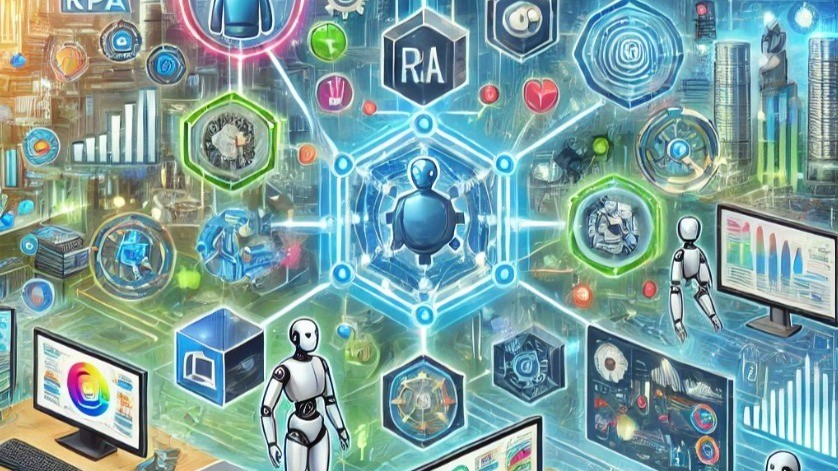
Analysts’ view on hyperautomation
Hyperautomation has been heavily featured in reports from many analyst houses, such as Gartner and Forrester. For Gartner, hyperautomation has been featured in their trends and reports, especially in the context of business transformation, and it has long been seen as a key part of the technological infrastructure of the future.
Gartner’s view on the future of hyperautomation:
- The Importance of Hyperautomation: Gartner has predicted that hyperautomation will be one of the key trends over the next few years as organizations look to reduce manual work and increase operational efficiency. Hyperautomation offers the opportunity to scale automation across the organization, accelerating digital transformation.
- 2024 and 2025 Trends: Gartner estimates that by 2025, 20% of all work in large enterprises will be automated, with hyperautomation emerging as a key driver for business optimization. This suggests that hyperautomation will be increasingly important in the future for both operational efficiency and strategic decision-making.
Gartner Magic Quadrant and Hyperautomation:
Although hyperautomation itself is not yet a categorized area in the Magic Quadrant, many related technologies and tools are included. For example, Robotic Process Automation (RPA) and intelligent business process management suites (iBPMS) are included in Gartner’s Magic Quadrant reports and are considered key components of the hyperautomation ecosystem.
Examples of Gartner Magic Quadrant reports:
- RPA (Robotic Process Automation): Gartner publishes an annual Magic Quadrant report on RPA solutions. Market leaders such as UiPath, Automation Anywhere and Blue Prism are strongly represented. These tools often play a central role in hyper-automation implementations, and are combined with artificial intelligence and machine learning to expand the possibilities of automation.
- Intelligent Business Process Management Suites (iBPMS): According to Gartner, iBPMS solutions such as Pega, Appian and IBM are significant tools for business process automation. These tools support hyperautomation by providing capabilities for workflow management, analytics, and AI-based decision-making.
Insights from Forrester and other analysts:
- Forrester: Forrester has also highlighted the importance of hyperautomation in accelerating digital business. According to Forrester, companies that adopt hyperautomation solutions can achieve significant benefits in cost savings, customer experience, and business agility.
- IDC: IDC has reported that hyperautomation will be one of the most critical technologies for companies looking to achieve the full potential of digital transformation by 2025.
Future prospects:
Analysts see the future of hyperautomation as a positive and growing area that will cover more and more business areas. The biggest development trends will be the following:
- Adding intelligence to automation: The future of hyperautomation is closely tied to the expansion of artificial intelligence and machine learning capabilities, especially in automating decision-making.
- Scalability of automation: Organizations want to scale automation beyond individual processes, and hyperautomation enables this by providing comprehensive integrations between different technologies.
- User-friendliness and no-code/low-code solutions: In the future, hyperautomation will be more accessible and manageable even for non-technical users, on no-code/low-code platforms.
The importance of hyperautomation is growing rapidly, and analysts expect its integration into more complex processes to continue to evolve with new technologies.
Preiskari Solutions and Liitos Solutions together design, implement and further develop the technologies required and used by Hyperautomation.
Our offering includes Workato’s technologies, which are core technologies in Hyperautomation.
Workato is a very popular hyperautomation platform, and its solutions cover several critical business areas where automation aims to improve efficiency and integrate with different systems. Workato focuses specifically on workflow automation and integrations between different systems. Here are the main areas where Workato solutions are utilized in the context of hyperautomation:
1. Business process automation
- Example: Workato can automate complex workflows such as order processing, inventory management, and invoicing by connecting different business systems such as ERP, CRM, and accounting systems.
- Benefits: This reduces manual processes, speeds up operations, and eliminates errors. With hyperautomation, these processes can become self-learning and adaptive through artificial intelligence.
2. Customer service automation
- Example: Workato can automate customer service workflows by connecting support ticketing systems, chatbots, and CRM systems. Chatbots can handle common queries, while more complex queries are routed to customer service agents.
- Benefits: Customer service requests are processed faster, while customer service representatives can focus on more complex tasks.
3. HR process automation
- Example: Workato offers tools to automate HR processes such as recruitment, employee onboarding, and onboarding. For example, applications can be automatically integrated into different systems, and onboarding processes can be automatically initiated after selection.
- Benefits: This improves the employee experience and saves time for the HR team.
4. Marketing and sales automation
- Example: Workato can integrate a CRM system (like Salesforce) with marketing automation tools (like Marketo or HubSpot), enabling real-time data sharing and campaign optimization.
- Benefits: Marketing and sales teams can respond faster to changes in customer behavior, leading to better prospect management and increased sales.
5. Finance and accounting automation
- Example: Workato can automate financial management processes, such as invoice processing and revenue recognition, by integrating accounting systems (such as QuickBooks or NetSuite) with other business systems.
- Benefits: The quality of financial reports improves, while manual input work and related errors are reduced.
6. IT process automation
- Example: Workato allows IT departments to automate processes such as software deployment, device management, and employee access management to systems. For example, it can automatically synchronize user management across systems when a new employee joins the organization.
- Benefits: The burden on IT departments is reduced and employees can be provided with a faster and smoother user experience.
7. Integration of cloud services and SaaS systems
- Example: Workato plays a key role in cloud-based SaaS integration. It enables seamless integration of various SaaS services, such as Google Workspace, Slack, and Microsoft Teams, with different business systems.
- Benefits: This enables rapid deployment and allows organizations to easily scale their operations in the cloud.
8. Automation of analytics and reporting
- Example: Workato can automate data collection and report generation from various sources, connecting analytics tools (like Tableau or Power BI) to business systems. Data is automatically collected and analyzed, allowing companies to make better decisions.
- Benefits: This reduces manual reporting and ensures that the data on which decision-making is based is always up-to-date.
Why is Workato key to hyperautomation?
Workato focuses strongly on low-code/no-code platforms that enable the building of complex workflows and automations without in-depth programming skills. This makes hyperautomation more accessible to the entire organization, not just IT departments. In addition, its extensive integration capabilities between different systems and SaaS solutions make it an ideal platform for hyperautomation scalability and flexibility.
Workato therefore helps companies integrate and automate workflows across a wide range of business areas, and is a key tool in the hyperautomation ecosystem.
If you are interested in hyperautomation, please contact us, let’s build your path to implementing and developing Hyperautomation together.








